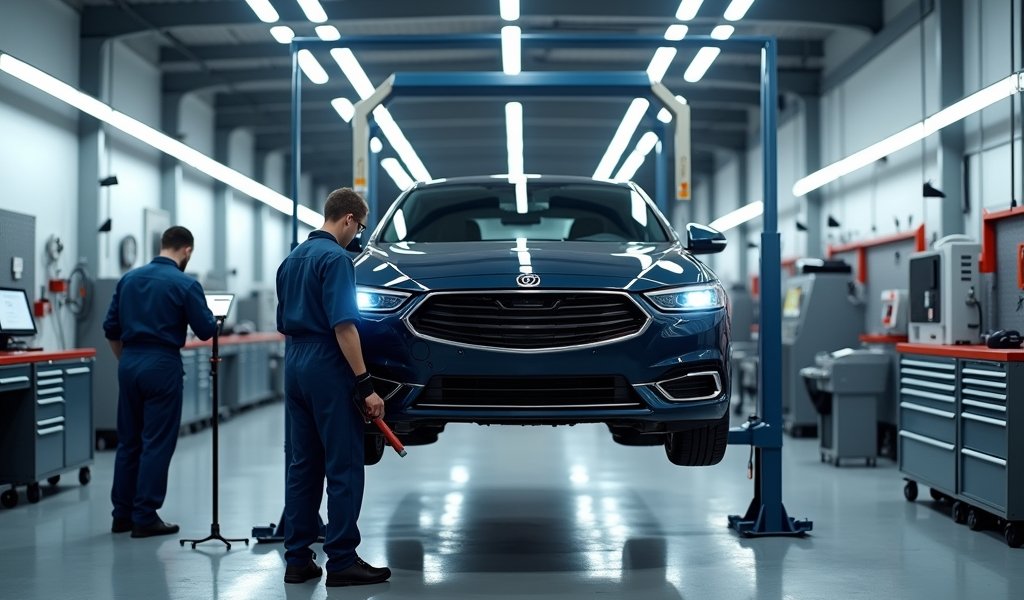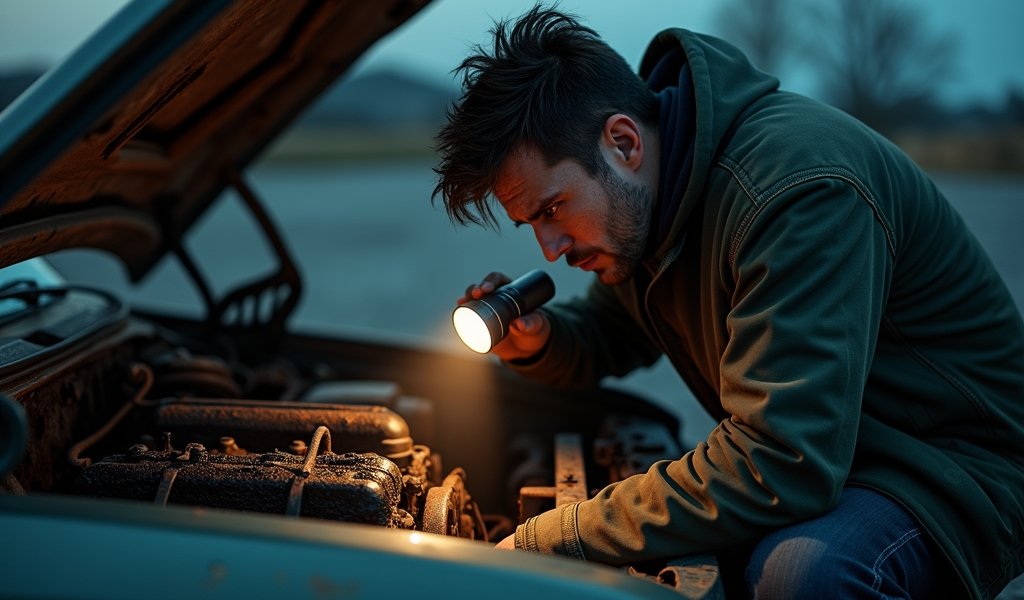Overview
This article provides a detailed five-step checklist for inspecting used cars, covering exterior examination, interior assessment, engine inspection, test driving, and professional evaluation to help buyers make informed decisions and avoid costly mistakes. Each step includes specific items to check and red flags to watch for, emphasizing that taking time for a thorough inspection can save thousands in unexpected repairs.
Table of Contents
- Buying a Used Car: Why an Inspection Checklist Matters
- Before You Begin: Getting Ready for the Inspection
- Step 1: Checking the Exterior
- Step 2: Examining the Interior
- Step 3: Looking Under the Hood
- Step 4: Taking a Test Drive
- Step 5: Getting a Professional Inspection
- Conclusion
- Frequently Asked Questions
Buying a Used Car: Why an Inspection Checklist Matters
Shopping for a used car can feel like navigating a maze. With so many options and potential hidden problems, it’s easy to feel overwhelmed. That’s where a used car inspection checklist comes in handy. Think of it as your road map to making a smart purchase decision.
I’ve seen too many folks rush into buying a car only to discover expensive problems later. In my 15 years as a mechanic, I’ve helped countless people avoid these costly mistakes. The good news? You don’t need to be a car expert to spot the warning signs of a problematic vehicle.
This guide breaks down the inspection process into five simple steps anyone can follow. By taking your time and knowing what to look for, you’ll feel more confident about your purchase and potentially save thousands in unexpected repairs. After all, a car is likely one of the biggest purchases you’ll make, so it pays to be thorough!
Before You Begin: Getting Ready for the Inspection
Before diving into our car inspection checklist, let’s gather what you’ll need. You don’t need fancy equipment – just a few basics will do the trick:
- Flashlight (for looking in dark spaces)
- Clean cloth or paper towels (to check fluid levels)
- Magnet (to check for body filler, which indicates repairs)
- Notebook and pen (to record findings)
- Your smartphone (for taking pictures and checking vehicle history)
Try to schedule your inspection during daylight hours – good lighting makes a huge difference when examining a car’s condition. If possible, look at the car when it’s dry, as water can temporarily hide paint and body issues.
Also, before visiting, ask the seller not to warm up the engine before you arrive. A cold start can reveal problems that might not be apparent with a warm engine. It’s a small detail that many buyers overlook but can tell you a lot about the car’s condition.
Finally, check the vehicle’s history report using the VIN (Vehicle Identification Number). Services like Carfax or AutoCheck can tell you if the car has been in accidents, had flood damage, or has a salvage title. This information costs a bit upfront but can save you from a costly mistake later on.

Step 1: Checking the Exterior
The outside of a car can tell you volumes about how well it’s been cared for and what problems might be lurking beneath the surface. Let’s start our inspection by taking a slow walk around the vehicle.
Body Condition
First, look at the car from a distance to check if it’s sitting level. A car that’s leaning to one side might have suspension problems. Next, examine the body panels closely for any signs of damage:
- Rust spots, especially around wheel wells and the bottom edges of doors
- Dents, scratches, or mismatched paint that could indicate repairs
- Panels that don’t line up evenly, which might mean the car was in an accident
Run your hand along the sides of the car to feel for ripples or unevenness in the paint. These subtle clues often reveal past body work that might not be obvious to the eye.
Glass and Lights
Check all windows, mirrors, and lights for damage:
- Look for cracks or chips in the windshield
- Make sure headlights, taillights, and turn signals work properly
- Check for moisture inside light fixtures, which could indicate seal problems
Replacing glass and lights can be surprisingly expensive, so these items shouldn’t be overlooked during your inspection.
Tires
Tires are literally where the rubber meets the road, and they can tell you a lot about the car’s condition. According to safety guidelines from the NHTSA, you should check:
- Tread depth (insert a penny upside down in the tread – if you can see all of Lincoln’s head, the tires need replacing)
- Even wear across all tires (uneven wear might indicate alignment problems)
- Matching brands on all four tires (different brands could suggest the owner cut corners)
- Manufacturing date (tires older than six years may need replacement regardless of tread)
Don’t forget to check the spare tire and make sure all the necessary tools for changing a flat are in the trunk. A good set of tires can cost $600-$1,000, so factor this into your budget if replacements are needed.
Step 2: Examining the Interior
The inside of a car can reveal how well the previous owner maintained it. It’s also where you’ll spend all your time, so make sure it’s comfortable and functional for your needs.
Seats and Upholstery
Start by checking the condition of all seats:
- Look for excessive wear, tears, or stains
- Test all seat adjustments to make sure they work
- If the car has leather, check for cracking or peeling
Don’t forget to check the headliner (the fabric on the ceiling) for sagging or stains that might indicate a roof leak. Examine the carpets for dampness or unusual smells, which could point to water damage or leaks.
Controls and Features
Now it’s time to test every button, switch, and feature:
- Air conditioning and heating systems
- Power windows and door locks
- Radio, speakers, and other entertainment features
- Dashboard warning lights (they should all light up when you first turn the key, then go off)
- Windshield wipers and washers
Modern cars have lots of electronic features, and repairs can be costly. Don’t assume something minor like a broken power window is an easy fix – in some cars, these repairs can run into hundreds of dollars.
Odor Check
Never underestimate your nose! Unusual smells can signal problems:
- Musty or moldy smells might indicate water leaks or flood damage
- Sweet smells could point to a coolant leak
- Burning oil or rubber smells might mean engine or belt problems
Take a moment to sit quietly in the car with all windows closed and just breathe. Sometimes odors become more noticeable after the car has been closed up for a few minutes.
When inspecting the interior, I always check under the used car maintenance essentials like floor mats and in the trunk for signs of rust or water damage. These hidden areas are often overlooked but can reveal serious problems.
Step 3: Looking Under the Hood
Now comes the part that intimidates many car buyers – checking under the hood. Don’t worry! You don’t need to be a mechanic to spot basic issues. Let’s break it down into simple steps.
Engine Inspection
First, make sure the engine is cool before starting your inspection. Then, with the car turned off:
- Look for any obvious leaks, corrosion, or damaged parts
- Check the battery terminals for corrosion (a white or greenish powder)
- Examine belts for cracks or fraying
- Inspect hoses for soft spots, cracks, or leaks
Now, ask the owner to start the engine while you watch. Look for excessive smoke from the exhaust and listen for unusual noises like knocking, ticking, or whistling sounds.
Fluid Checks
Checking fluid levels and condition can tell you a lot about a car’s health:
- Oil: Pull out the dipstick, wipe it clean, reinsert it, and check again. The oil should be between the min/max marks and appear brownish (not black or milky)
- Transmission fluid: Similar to oil, but the fluid should be pinkish and not smell burnt
- Coolant: Look at the overflow reservoir to check level and color (should be green or orange, not rusty)
- Brake fluid: The reservoir is usually translucent so you can check without opening it. The fluid should be clear to amber, not brown
Low fluid levels or dirty fluids could indicate neglected maintenance or leaks. According to Consumer Reports’ used car buying guide, fluid issues can often predict more serious and expensive problems down the road.
Check for Modifications
Look for aftermarket parts or modifications under the hood. While not necessarily bad, modifications might indicate the car was driven hard or could cause warranty issues. If you notice modifications, ask the seller about them – why they were made and who did the work.
Remember, a clean engine bay doesn’t always mean a problem-free car. Some sellers clean the engine to hide leaks, so look carefully at the ground under the car for signs of dripping fluids.

Step 4: Taking a Test Drive
The test drive is perhaps the most important part of your inspection. This is where problems that aren’t visible during a static inspection often reveal themselves. Plan a route that includes different road types and speeds to thoroughly test the vehicle.
Before You Start
Before putting the car in drive:
- Adjust the seat, mirrors, and steering wheel to your comfort
- Turn off the radio so you can listen to the car
- Make sure your insurance covers you for test drives
Start the engine when it’s cold if possible. A properly functioning car should start promptly without excessive cranking or strange noises.
During the Drive
As you drive, pay attention to these key areas:
- Acceleration: The car should accelerate smoothly without hesitation or jerking
- Braking: Brakes should feel firm, not spongy, and the car should stop in a straight line without pulling to either side
- Steering: The wheel should turn smoothly without excessive play or vibration
- Transmission: Gear shifts (whether automatic or manual) should be smooth and timely
- Suspension: The ride should feel stable over bumps without excessive bouncing or noise
Try to drive at both city and highway speeds if possible. Some issues only show up at higher speeds, like vibrations that might indicate tire balance problems or alignment issues.
Special Tests
Include these specific tests during your drive:
- Find a safe, empty parking lot to make tight turns in both directions, listening for clicking or popping sounds that might indicate CV joint problems
- Drive over a speed bump slowly to check suspension noises
- On a safe, straight, empty road, briefly take your hands off the wheel (while maintaining control!) to see if the car pulls to one side
- Test the emergency brake on a slight incline if possible
After the drive, check under the car again for any fresh fluid leaks that might have appeared. A good test drive should last at least 30 minutes to give the car enough time to reach operating temperature and for any issues to surface.
When test driving, I always recommend taking someone along who can help with the maintenance evaluation. An extra set of eyes and ears can catch things you might miss while focusing on driving.
Step 5: Getting a Professional Inspection
Even if you’ve been thorough with your own inspection, having a professional mechanic check the car can provide peace of mind and potentially save you from a costly mistake. Think of it as an investment – spending $100-$200 now could save you thousands later.
Finding the Right Inspector
Not all inspections are created equal. Here’s how to get a good one:
- Look for a mechanic who specializes in the make of the car you’re considering
- Ask for a used car pre-purchase inspection specifically, not just a general check
- Request a written report of findings, not just a verbal summary
- If possible, be present during the inspection so you can ask questions
Many repair shops offer pre-purchase inspections, but dealership service departments and mobile inspection services are also options. The AAA Approved Auto Repair network can help you find qualified mechanics in your area.
What the Professional Should Check
A professional inspection should go beyond what you can see and include:
- Computer diagnostic scan to check for error codes
- Compression test to evaluate engine health
- Undercarriage inspection for frame damage, rust, or leaks
- Brake pad and rotor measurements
- Examination of suspension components
Ask the mechanic to prioritize any issues they find. Something that sounds scary might be a simple fix, while seemingly minor problems could be warning signs of bigger issues.
Using the Inspection Results
Once you have the professional’s report, you have several options:
- Walk away if serious problems are found
- Negotiate a lower price based on needed repairs
- Ask the seller to fix certain issues before purchase
- Budget for upcoming maintenance if only minor issues are identified
Remember, no used car will be perfect. The goal is to understand what you’re buying and make an informed decision about whether the car offers good value considering its condition.
Conclusion
Following this used car inspection checklist puts you in the driver’s seat when making your purchase decision. By thoroughly examining the exterior, interior, engine, taking a comprehensive test drive, and getting a professional opinion, you’ll dramatically reduce your chances of ending up with a problematic vehicle.
Remember, buying a used car is a process that rewards patience and attention to detail. Don’t feel rushed or pressured – there are plenty of cars out there, and the right one is worth waiting for. Trust your instincts too. If something doesn’t feel right about the car or the seller, it’s okay to walk away.
With the knowledge you’ve gained from this guide, you’re now equipped to approach used car shopping with confidence. A good inspection takes time, but it’s time well spent considering how much money and frustration it can save you down the road.
Happy car hunting, and may your next used car bring you many miles of trouble-free driving!
Frequently Asked Questions
How long should a used car inspection take?
A thorough personal inspection should take 45-60 minutes, not including the test drive. Professional inspections typically take 1-2 hours depending on the vehicle’s complexity.
Is it worth paying for a professional inspection?
Absolutely! A professional inspection typically costs $100-$200 but can save you thousands in unexpected repairs. It’s especially important for higher-priced vehicles or those without maintenance records.
Can I use this checklist when buying from a dealership?
Yes, this checklist applies to all used car purchases, whether from private sellers or dealerships. Even certified pre-owned vehicles deserve a careful inspection.
What’s the most important part of the inspection process?
The test drive is arguably the most crucial as it reveals operational issues that static inspections might miss. Pay special attention to how the engine, transmission, and brakes perform during different driving conditions.
Should I get a vehicle history report?
Yes, always obtain a vehicle history report using the VIN. These reports reveal accidents, title problems, service records, and ownership history that the seller might not disclose.


Pingback: ball joint wear indicator: 5 Pro Fixes - knowsyourcar.com
Pingback: disc brake rotor thickness measurement?! - knowsyourcar.com
Pingback: Tread Depth Gauge Measurement Top 5 Tips - knowsyourcar.com